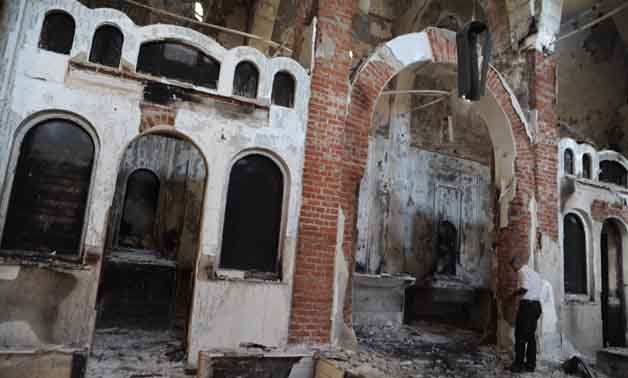
Saint Tadros Coptic Orthodox Church in Upper Egypt's Minya on Aug.22, 2013- File Photo
CAIRO – 14 August 2017: It’s been four year since the dispersal of the Rabaa sit-in, and 4 years since dozens of churches nation-wide took the brunt of the outlawed Muslim Brotherhood’s anger about the dispersal.
Fifty-two churches were attacked in a 24-hour time period, Head of the Coptic Orthodox Church, Bishop Angaelos, had said at the time. By the end of the dispersal on August 19, a total of 73 churches across Egypt were attacked.
The Brotherhood members regarded attacking the churches as their revenge against Coptic Egyptians who made their stance against the Brotherhood and support for the Armed Forces quiet clear during the June 30 revolution.
All the churches that were attacked during the dispersal have since been rebuilt or renovated, according to Bishop Baiman, President of the Crisis Committee at the Holy Synod, and the supervisor of the restoration missions.
The restoration was done in three phases, he explained, simple restoration, advanced restoration and complete rebuilding of the churches. He added that a significant number of the churches had to be rebuilt. He expressed his gratitude to the Egyptian state for keeping their promises to the Coptic Christians, and said that their situation has improved significantly under President Abdel Fatah al-Sisi.
The President of the Evangelical Community in Egypt, Andrea Zaki, said that 14 churches and a community services building were restored. The attacks on churches were painful and upsetting, he stated, and it made him feel unsafe.
Churches located in Upper Egypt took the lion’s share of vandalized churches. Minya had the upsetting distinction of being ranked first in attacks with the Church of St. Mina of the Coptic Orthodox Church, Church of Saint Mark, and Pastor of the Church of the Virgin Mary and Anba Abram in Daljah all being attacked.
The security guards of the Minya churches share their harrowing experiences during the attack.
“I sat in the church until I heard sounds and chants coming in the direction of the church so I hid behind the door,” said ‘Am Attia. He described a pickup truck slamming into the church’s door until it knocked it over. Hundreds of men then stormed into the church carrying weapons, explosives and Molotov cocktails and carried all that they can and left, ‘Am Attia said.
They took the donations that were meant for orphaned brides, he said, as well as computers from the Church Club Room and even the mirrors in bathrooms and television screens that used to stream prayers.
They then proceeded to set fire to the church and turn it into ashes, he said.
“During the fire, I snuck the Father out the backdoor so that they don’t kill him if they see his clerical clothing,” ‘Am Attia said, “I then watched the unfolding from a distance.”
On the morning of August 19, Anba Macarius insisted on carrying out the prayers on the debris of the church.
The horror of that night persisted for months to come, but the priests insisted on going through with the prayers.
.jpg) Aftermath of post Rabaa dispersal violence at Diocese Great Martyr St. George in Sohag in August 2013 - File Photo
Aftermath of post Rabaa dispersal violence at Diocese Great Martyr St. George in Sohag in August 2013 - File Photo
Amir Tadros St., which Minya Copts now call Pain Street, witnessed the burning down of two Christian schools, the historic Saint Tadros Coptic Orthodox Church, Saint Tadros pharmacy, an orphanage, a catholic school and personal belongings of Coptic individuals.
The street is located at the intersection of the park, where Brotherhood members used as their own Rabaa Square, making it the first target for the angry Brotherhood members during the dispersal.
‘Am Gerges tells the story of the attack on the orphanage. Orphanage personnel were instructed to hand over the boys to any relatives they have, after a broadcast on TV showed a man being thrown off the roof in Alexandria and showing the extent of the violence following the dispersal.
Just hours after the children were handed to relatives, the building was invaded. The men stole computers, air conditioners and even drawers with the children’s belongings and paperwork.
They proceeded to climb to the roof of the building where ‘Am Gerges was hiding in a tiny room. He said they opened fire on neighboring houses where Copts live.
“I turned my phone off so they wouldn’t hear it if someone called me,” ‘Am Gerges said of his horror that night, “I looked death in the eyes.”
Saint Tadros Coptic Orthodox Church was completely obliterated according to ‘Am Gerges and the keeper of the church. The bibles were burnt, the altar was destroyed and icons were scattered on the floor. They set the church on fire, and it kept burning until the entire first floor collapsed.
The prayers never stopped, the keeper assured. During restoration work, prayers took place in a tent in the church’s courtyard so that the “blessings don’t leave the place.”
.jpg)
Comments
Leave a Comment